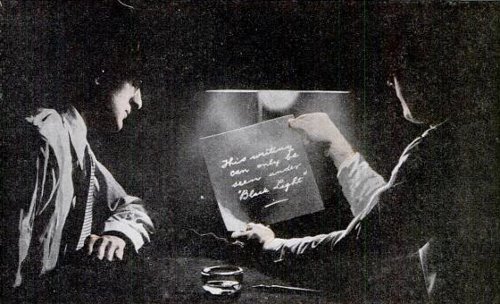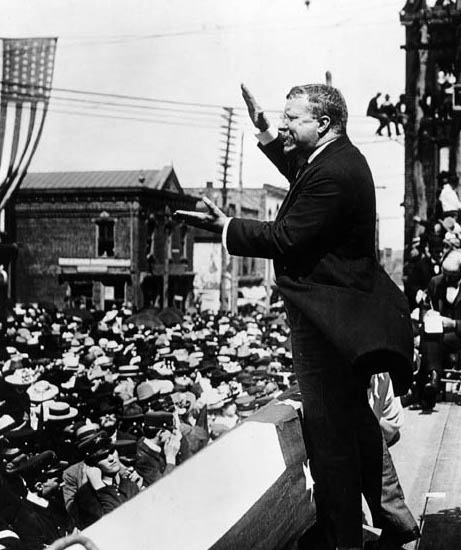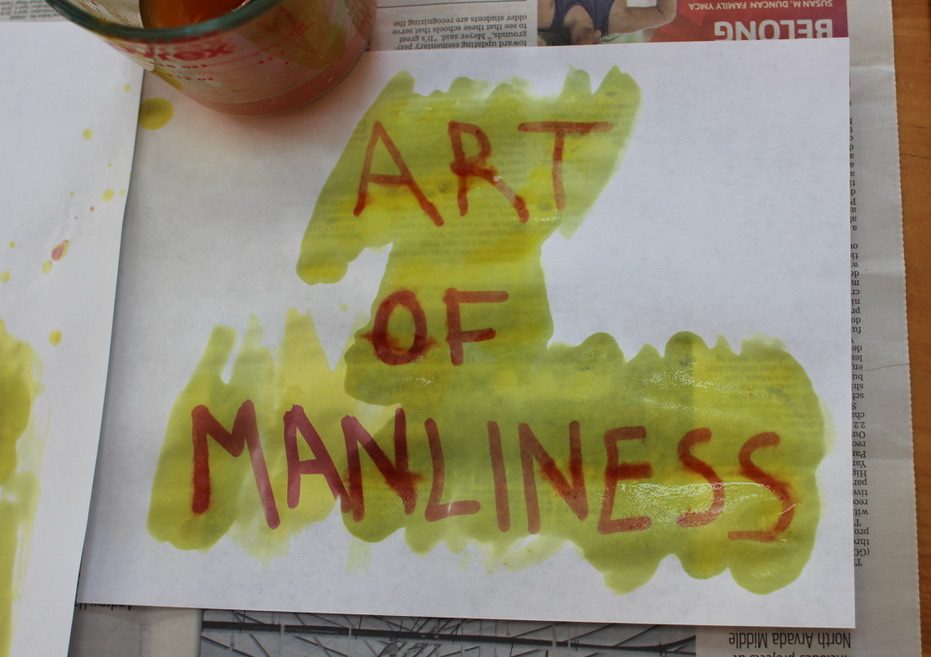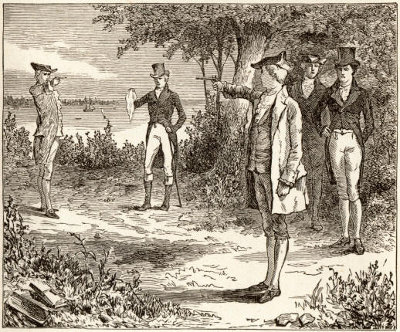While the use of invisible ink has now been almost entirely eclipsed by modern technology, its history is incredibly fascinating, and today as part of our Man Knowledge series we’ll explore its use through time.
The Basics of Invisible Ink
There are two categories into which invisible inks fall: organic fluids and sympathetic inks. The former consists of the “natural” methods many of us tried our hand at as kids: lemon juice, vinegar, milk, sweat, saliva, onion juice, and even urine and diluted blood, to name a few. These organic invisible inks can be developed through heat, such as with fire, irons, or light bulbs, and some can be seen when placed under ultraviolet light. The organic fluids alter the fibers of the paper so that the secret writing has a lower burn temperature and turns brown faster than the surrounding paper when exposed to heat.
Sympathetic inks are more complicated chemical concoctions. Sympathetic inks contain one or more chemicals and require the application of a specific “reagent” to be developed, such as another chemical or a mixture of chemicals.
The History of Invisible Ink
The history of invisible ink is mainly the history of war, for it is during such times that intrigue, espionage, and spying is at its most vital and necessary.
Ancient Times and the Renaissance
The history of invisible ink goes back more than 2,000 years and was used by the ancient Greeks and Romans. The first record of it comes from Pliny the Elder in the first century AD, who mentioned using the milk of the tithymalus plant as an invisible ink in his Natural History. Invisible ink continued to be used during the Renaissance; statesmen used it in their letters, and Ovid references the practice in his Art of Love. Giovanni Battista della Porta, an Italian polymath, developed a formula for invisible ink that consisted of an ounce of alum and a pint of vinegar. Once painted on the shell of a hard-boiled egg, it would seep through and transfer the message onto the egg’s albumen. The writing could only be seen once the egg was peeled.
The Revolution
During the Revolutionary War, both the British and the Americans used invisible ink. The British used both organic fluids and common sympathetic inks. Major John Andre, the chief British intelligence officer, had agents put a letter in the corner of their correspondence to inform the recipient as to how the hidden secret message could be developed; for example, an “F” was placed in the corner of letters that could be revealed by fire, an “A” for those that needed the application of an acid.
But George Washington wanted something more, an ink that could only be revealed by a unique, specially formulated reagent. Sir James Jay answered the general’s call. Jay, brother of American patriot John Jay and a physician that dabbled in chemistry, created a “sympathetic stain,” which he supplied to Washington. Washington would then pass it on to the Continental Army’s spymaster, Major Benjamin Tallmadge who in turn provided it to the members of the famous Culper Spy Ring: Abraham Woodhull and Robert Townsend. To avoid suspicion, Washington instructed his spies to write seemingly banal letters between the lines of their secret messages, or to inscribe them “on the blank leaves of a pamphlet. . . a common pocket book, or on the blank leaves at each end of registers, almanacks, or any publication or book of small value.”
World War I
In contrast to the billion-dollar-budgeted intelligence agencies of today, when America entered the First World War, the CIA did not exist, and the FBI was barely 15 years old. The Office of Naval Intelligence coordinated the gathering of the country’s intelligence.
 In a pamphlet included in the recently unclassified documents mentioned in the introduction, we can see that chemical inks were employed during this time, but basics like lemon juice and milk were still in use as well. While the Americans were falling back on old favorites, the Germans were at the leading edge of invisible ink development. At the beginning of the war, the Germans used inks made from headache and fever remedies and laxatives; these were handy as they could be passed off as common medicines. But when the Allies caught on, they were forced to develop inks outside those based on common household items. They utilized inks made from iron sulfate, copper sulfate, and cobalt salts, and employed reagents of sodium carbonate, ammonia fumes, and potassium ferroscyanide.
In a pamphlet included in the recently unclassified documents mentioned in the introduction, we can see that chemical inks were employed during this time, but basics like lemon juice and milk were still in use as well. While the Americans were falling back on old favorites, the Germans were at the leading edge of invisible ink development. At the beginning of the war, the Germans used inks made from headache and fever remedies and laxatives; these were handy as they could be passed off as common medicines. But when the Allies caught on, they were forced to develop inks outside those based on common household items. They utilized inks made from iron sulfate, copper sulfate, and cobalt salts, and employed reagents of sodium carbonate, ammonia fumes, and potassium ferroscyanide.
Both sides worked to find a universal reagent that could develop every invisible ink, no matter its chemical composition. The Allies struck upon a solution when they discovered that iodine vapor would turn all invisible inks brown. It worked not by chemical reaction, but by revealing where the the paper’s fibers had been altered with moisture.
But the Germans then came up with a simple counter-measure; after inscribing a secret message, they would wet the entire paper by steaming it, thus altering all of the paper’s fibers. After the paper was allowed to dry, it was sent on to its destination.
Both sides had to come up with sneaky ways to hide their inks as well. American agents were advised to impregnate their shirt collars and handkerchiefs with a solution of sodium nitrate; these items could later be soaked in water to create an ink. German spies employed a similar tactic by soaking their ties in chemicals that were later reconstituted. Ready-made inks were often placed inside of shaving sticks and hollowed out soap cakes and hair brushes. Agents also dipped matchsticks into the inks and let them dry; the matches could then be carried without arousing suspicion and used as writing utensils when it came time to inscribe a secret message.
American spies also wrote secret messages on their body which could only be developed when sprayed by an atomizer. Messages were even engraved on toenails; a dusting with powdered charcoal revealed the etchings.
World War II
During WWII both the Allies and the Axis powers worked hard on developing their own invisible inks and discovering the inks used by the enemy. This battle between laboratories became a veritable arms race, with each side trying to out do the other and come up with that holy grail of invisible inks: one that was odorless, could be developed by as few reagents as possible, and could not be exposed by heat, detected with iodine, or revealed by ultraviolet light.
The Abwehr, Germany’s military intelligence agency, had five levels of inks, and gave the most complicated ones to its best agents (less trusted spies could have possibly been double-agents who would have turned the secrets over to the Allies). To develop one of the inks, the recipient had to moisten the paper, sprinkle it with a red powder containing naphthalene, heat it to 140 degrees Fahrenheit, and expose it to ultraviolet light. Another crafty ink required activation by blood–the agent pricked his finger and added a drop to the mix before writing.
The Allies and Axis powers also tried to outdo each other when it came to revealing the secret inks used by the other side. As it did during WWI, the American government vigorously screened mail coming in and out of the country. 14,462 censors opened a million pieces of mail a day; correspondence that aroused the censors’ suspicions was sent on to the FBI for further testing. 4,600 pieces of mail were forwarded to the government’s labs, and 400 of these items turned out to contain secret writing and codes.
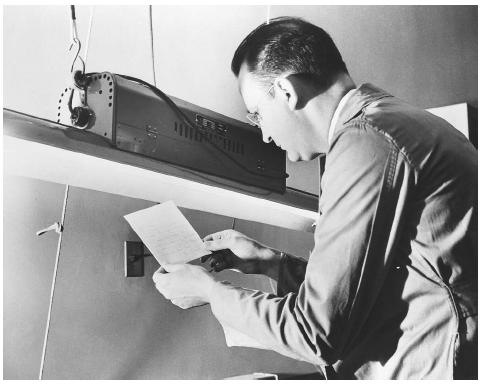 Censors would expose suspicious papers to heat, ultraviolet light, and iodine vapors. They would also stripe them with a tool that consisted of multiple brushes wired together. Each brush had been dipped in a different reagent, and the tool was swept across the page to check for reactions.
Censors would expose suspicious papers to heat, ultraviolet light, and iodine vapors. They would also stripe them with a tool that consisted of multiple brushes wired together. Each brush had been dipped in a different reagent, and the tool was swept across the page to check for reactions.
The Germans then counteracted this detection method by formulating an ink that required three applications of a reagent spaced three hours apart.

The Allies and Germans also tried to outwit each other in where they wrote their messages. Knowing that letters themselves were scrutinized, they wrote on the under-side of an envelope’s flap, brushed certain words and phrases in a newspaper with ink, and wrote messages on handkerchiefs. When the German spy George Dasch, who landed with his co-conspirators in a submarine on Long Island, surrendered to the FBI, in his pocket was found a handkerchief on which the names and addresses of his contacts had been written in invisible ink.
The Cold War
During this Golden Age of Espionage, countries threw serious time and resources into developing spy tools and technology that would keep them steps ahead of the enemy. This included research into ever more effective and sophisticated invisible inks.
One major advancement took the form of a new method of writing. The time-honored technique had been wet-writing; the person wrote directly with the ink on the paper. But this process had significant drawbacks. The agent had to steam the paper to prepare it, let it dry, write his message, re-steam the paper to remove the indentations made with the writing utensil, let it dry again, and then write a visible message to cover up the invisible one. And even after all this, traces of the writing could still be found by trained technicians on the other side.
The Soviet KGB and East German Stasi developed an alternative during the 1950s: the dry transfer method. Instead of directly putting the ink on the paper, a chemically impregnated sheet of paper was placed between two sheets of ordinary writing paper. The secret message was written on the top sheet and transferred through the chemicals on the middle sheet to the bottom sheet. The top sheet was destroyed altogether (it was often made of a water soluble material that could be flushed away or dissolved in a cup of water), and the bottom sheet was left with an undetectable message. The chemical sheets could be re-used many times before they had to be discarded. This dry method was even utilized by American POWs during the Vietnam War to sneak secret information into their letters home.
The development of numerous plastic products during the 60s gave agents a new way to write their messages as well. The CIA would embed chemicals in common products like credit cards, pen caps, eyeglass frames, key fobs, and even the plastic toothpick in a Swiss Army knife. The agent then simply had to rub the plastic object on paper to transfer the invisible “ink.”
These and other advancements were coming from the well-staffed laboratories of the intelligence agencies of the 50s and 60s. The Stasi’s Technical Operations Sector had 50 employees working on secret writing alone. The CIA had 36 secret writing specialists employed domestically and abroad.
As the Cold War drew to a close, the number of chemists and physicists devoted to working on invisible ink was reduced, and the demise of snail mail and advancements in technology slowly rendered the use of invisible ink, if not obsolete, then a much less vital tool in a spy’s bag of tricks. But who knows? Perhaps when that “insurance salesman” you met at the airport offered you his handkerchief, you were really blowing your nose into the names of suspected terrorists.


